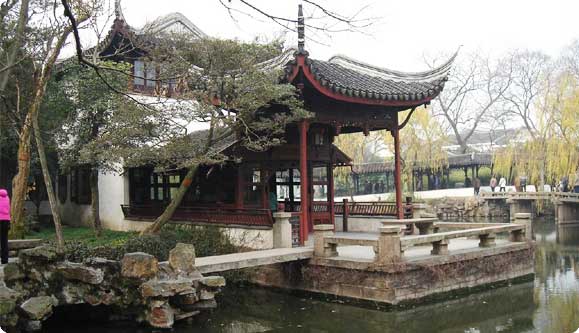The Surging Waves Pavilion
沧浪亭

Celebrated for the delights of the wilderness of mountain and forest scenery, the Surging Wave Pavilion is the oldest among the existing classical gardens of Suzhou. On the whole the present garden of the Surging Wave Pavilion still keeps the style of the Song. It features a range of man-made mountains inside the garden and waterscapes outside. Proceeding past the pure expanse of water over a zigzag bridge of stone and through the entrance, one comes to the garden and catches sight of man-made mountain covered with age-old trees and bamboo, running from east to west. At the foot of the mountains are rocky slope wash. The Surging Wave Pavilion in the shape of a square stands at the top of the mountain and has a parallel couplet from the Song poets on the stone pillars to heighten artistic conception. Most of the garden buildings, simple and plain, were rebuilt in the Qing Dynasty, carefully arranged around the mountains and connected by a long roofed walkway. A double-corridor built by the canal lies to the north of the garden, unifying waterscapes outside the garden and "mountain scenery" inside in one breathes through its latticed windows, one of incredible examples of borrowed scenes in the classical gardens of Suzhou. There're over 100 different latticed windows with impressive designs, possessing extremely high artistic value.
To the south of the mountains is the chief building of the garden, called "the Enlightenment Hall". Other building include the Smelling Prunes Mum Pavilion, the Realm of Yaohua (Yaohua is said to be a kind of jade-like, sweet-smelling flower in the Chinese garden of Eden, which can help prolong the life expectancy of those who behold it.),the Mountain-in-View Tower, the Elegant Bamboo House, the Temple of 500 Sages, the Pure Fragrance House, the Imperial Stele Pavilion, the Pavilion Fronting Water, the Fish Watching Spot, the Water Pavilion of Lotus Fragrance, and the Prunes Mum Pavilion.
|



